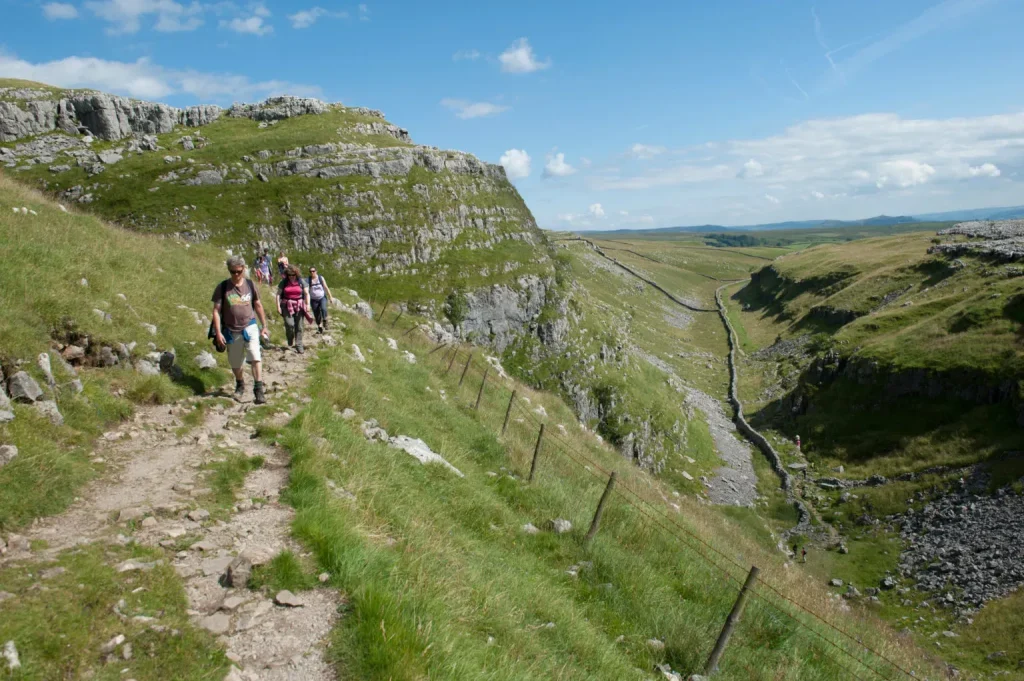Hiking the Pennine Way is more than just a leisurely stroll; it’s a journey steeped in history and adventure. As the UK’s first national trail, established amidst the struggle for outdoor access, the Pennine Way trail offers stunning landscapes and a tangible connection to the history of hiking in the region. This long-distance walking route stretches an impressive 268 miles through the breathtaking Pennine hills, celebrating its 60th anniversary as an emblem of hikers’ rights and the beauty of the British countryside. With iconic sections like High Cup Nick and the rugged terrain of Cross Fell, this trail draws enthusiasts from across the nation and beyond. Embracing both nature and history, Hiking the Pennine Way invites people to explore the heart of the UK national trails in their celebration of walking and adventure.
Exploring the Pennine Way is a remarkable experience that takes trekkers on a captivating journey through northern England’s scenic landscapes. As the inaugural national pathway in the UK, this extensive walking route unfurls over 268 miles, offering a rich blend of natural beauty and cultural heritage. Celebrated for its 60 years of existence, this trail has become a beacon for hikers, exemplifying the enduring legacy of long-distance walking in the region. The story of the Pennine Way intertwines with the history of access rights, encouraging modern explorers to delve into the breathtaking views and unique geological features along the route. Whether you refer to it as the Pennine Way or the backbone of England, this trail delivers not just miles but a profound connection to the land and its stories.
The Evolution of Hiking Gear on the Pennine Way
Hiking gear has significantly transformed since the inception of the Pennine Way in 1965. In the early days, hikers like Joyce Neville had very few options when it came to appropriate clothing and equipment. Women were typically expected to don long tweed skirts, which were considered the norm for walking attire, while men wore more practical yet similarly outdated clothing. Fast forward to today, and you will find a plethora of choices, including lightweight, waterproof jackets and breathable, fleece-lined trousers designed for maximum comfort during long-distance walking. The evolution of hiking gear not only reflects advances in fabric technology but also a shift in societal norms regarding what is acceptable attire for women in outdoor pursuits.
Additionally, the tools and supplies carried by hikers have evolved from heavy canvas bell tents and cumbersome cooking gear to modern lightweight options. Today, many hikers opt for portable camp gear and pre-prepared meals, allowing them to focus more on the experience than the logistics of survival. The introduction of budget-friendly accommodations along the Pennine Way, like guesthouses and Airbnbs, also means that the necessity of carrying heavy tenting equipment has diminished. Overall, this evolution in hiking gear contributes significantly to the accessibility of the Pennine Way trail for both occasional hikers and seasoned trekkers.
Frequently Asked Questions
What is the history of hiking the Pennine Way trail?
Hiking the Pennine Way trail has its roots in the 1935 mass trespass of Kinder Scout, which aimed to secure the right to roam. The trail, officially opened in 1965, was the first national trail in the UK and has since celebrated over 60 years of long-distance walking.
How has hiking the Pennine Way changed from its inception to today?
When hiking the Pennine Way first began, like in the 1950s with early hikers such as Joyce Neville, treks were more challenging due to lack of pathways and facilities. Today, thanks to improvements like flagstones on boggy sections and the accessibility of accommodation, long-distance walking on the Pennine Way trail has become much more approachable.
What should I know about gear for hiking the Pennine Way?
For hiking the Pennine Way, lightweight and waterproof gear is essential. Modern hikers benefit from advances in technology, allowing them to wear comfortable clothing, unlike the heavy outfits worn during the trail’s early years. Proper hiking boots and waterproof jackets are recommended for varying weather conditions.
What are the highlights of hiking the Pennine Way?
Hiking the Pennine Way offers stunning highlights including High Cup Nick, often referred to as England’s Grand Canyon, diverse wildlife, and picturesque landscapes across the Pennines. With a distance of 268 miles, the trail provides a unique experience of the UK’s natural beauty.
How can I celebrate the Pennine Way 60th anniversary?
To celebrate the Pennine Way 60th anniversary, consider taking on a hiking challenge along the trail, participating in local events, or learning about its history through guided walks and community efforts to promote and preserve the trail.
What types of accommodation are available on the Pennine Way?
Along the Pennine Way, accommodation varies from Youth Hostels, guesthouses, and inns to camping options. While some hostels have closed since the trail’s inception, a mix of modern accommodation ensures hikers have a range of choices to suit their preferences.
Why is the Pennine Way significant in UK national trails?
The Pennine Way is significant as the UK’s first national trail, inspiring the establishment of more than 17 national trails across England and Wales. Its creation highlights the ongoing struggle for hiking rights and access to the countryside.
What challenges might hikers face on the Pennine Way?
Hikers on the Pennine Way may face challenges such as unpredictable weather, rugged terrain, and the physical demands of long-distance walking. It’s crucial to prepare adequately, be aware of varying conditions, and plan accommodations in advance for a successful hike.
Are there any organized events for hiking the Pennine Way?
Yes, various organized events and guided walks are offered to mark milestones, such as the Pennine Way’s 60th anniversary. These events often encourage participation from all skill levels and emphasize the communal aspect of hiking the trail.
What role does hiking play in promoting environmental awareness?
Hiking the Pennine Way not only provides enjoyment and recreation but also promotes awareness about land access, conservation, and environmental issues. Engaging with the history and natural beauty of the trail can foster a greater appreciation for protecting these landscapes.
| Key Points | Details |
|---|---|
| Overview of the Pennine Way | UK’s first national trail established in 1965 to secure the right to roam. |
| Significant anniversary | Celebrating 60 years since the trail’s creation and 70 years of its early walks. |
| Historic Hikers | Women like Joyce Neville paved the way for future hikers by participating in early walks. |
| Trail Experience | Walking through varied landscapes such as glacial valleys, farming areas, and along riverbanks. |
| Hiking Equipment Changes | From heavy, traditional gear to modern lightweight, waterproof hiking attire. |
| Accommodation Evolution | Transition from camping in farmers’ fields to using guesthouses, B&Bs, and some remaining hostels. |
| Cultural Importance | The trail is rooted in political history, pushing for access rights for all walkers. |
| Future of Hiking | Access issues persist; campaigning groups advocate for more right-to-roam opportunities. |
Summary
Hiking the Pennine Way is not just a journey through stunning landscapes but also a walk through history reflecting the evolution of walking rights in the UK. Over the past 60 years, the trail has transformed from a challenging trek through bogs tackled by pioneers like Joyce Neville to a more accessible route adorned with modern amenities. Today, the Pennine Way continues to symbolize the ongoing struggle for outdoor access, urging us to embrace the great outdoors while advocating for hikers’ rights.



